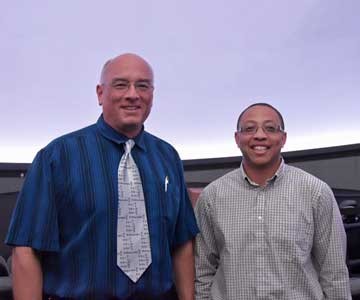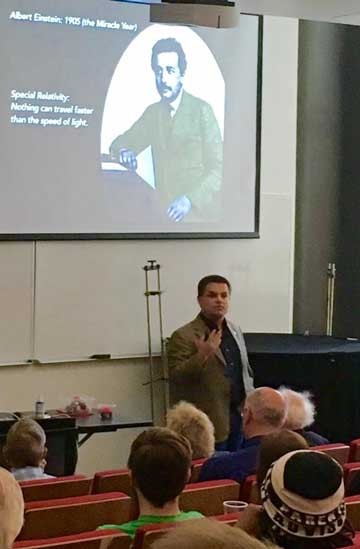Center for the Sciences introduces planetarium, a key new destination for science education

Radford University unveiled its new planetarium in the Center for the Sciences April 29-30 with a weekend of science and exploration.
Visiting physicists Michelle and Shane Larson from Chicago’s Adler Planetarium, keynoted the weekend with a pair of engaging lectures and the planetarium rolled its premiere show, “The Violent Universe.” A full house of alumni, faculty and students explored the solar system and far reaches of the galaxy with the planetarium’s crisp, digital projection and surround sound systems.
The planetarium with 55 theatre-style seats is an upgrade from its original location in the basement of Reed-Curie Hall to which over 40,000 students and space fans came to explore the cosmos in its 16 years there. The planetarium and the Museum of Earth Sciences, set to open this fall, are centerpieces of the Center for the Sciences’ main floor.
The Center for the Sciences is driving Radford’s College of Science and Technology to become a premier destination for serious students to conduct original research with faculty mentors and those seeking to master modern research techniques and equipment, as well as science teachers and area residents interested in science education.
“The whole idea behind the planetarium is to use this unique and sophisticated place to explore more disciplines, not just astronomy and physics,” said Rhett Herman, professor of physics and planetarium director, who sees the planetarium’s graphic capabilities as a potential platform for presentations on arts and other sciences, such as chemistry.
“Chemists deal with 3D imagery that they must conceptualize by looking at 2D figures,” said Herman. “The planetarium can provide a medium with which to demonstrate molecules and truly see them in three dimensions.”

Shane Larson, a research associate professor of physics at Northwestern University and a member of the Center for Interdisciplinary Exploration and Research in Astrophysics, launched the astronomical weekend. His lecture, titled “From Black Holes to LIGO: The Dawn of Gravitational Wave Astronomy” detailed the exciting discoveries coming from the Laser Interferometer Gravitational-Wave Observatory (LIGO) project. According to Larson, a recent discovery by the international project supports Einstein’s general relativity theory by deepening science’s understanding of gravitational waves and the interplay between the space/time continuum and matter.
As part of the Center for the Sciences “Science on Display” initiative, the planetarium hopes to reach audiences of all kinds. Herman said he anticipates the planetarium becoming a unique destination for visitors to New River Valley.
“For example, we have the ability to display math in exciting ways,” said senior physics major Joshua Carroll, one of three student assistants who have helped bring the facility on line. “We’ll be able to reach audiences in different ways and make them excited about the planetarium, science and exploration.”
Michelle Larson, president and CEO of the Adler Planetarium, capped the unveiling weekend with a lecture titled, “Science has a Story to Tell.” Larson shared insights from Adler, which has attracted almost a half million visitors, about how scientific outreach is part of the academic culture.
“Humans are natural scientists . . . always wondering, observing and discovering,” Michelle Larson said. “Frontier science is what’s new today and enthusiasm is driven by discovery.”
For more information about the planetarium or scheduling a visit when it opens this fall, contact Rhett Herman at rherman@radford.edu or visit the planetarium home page.